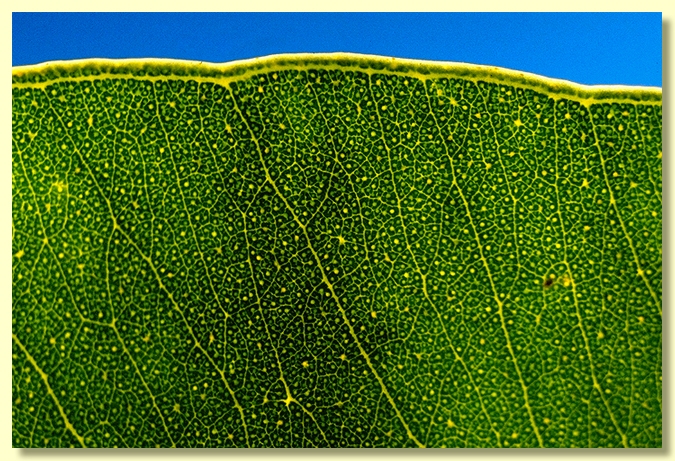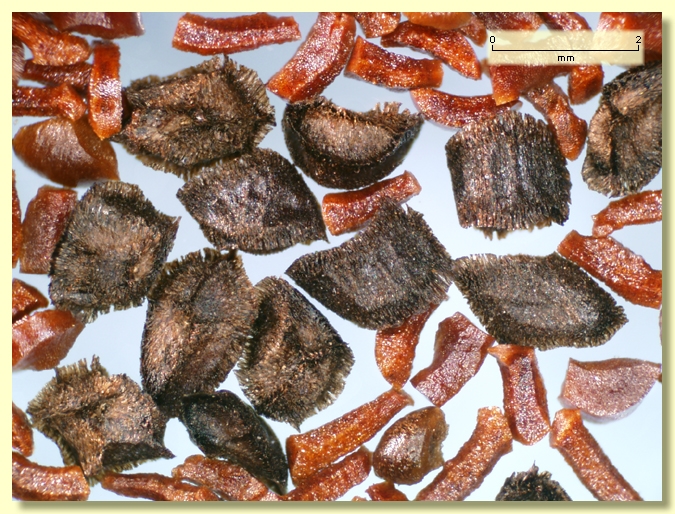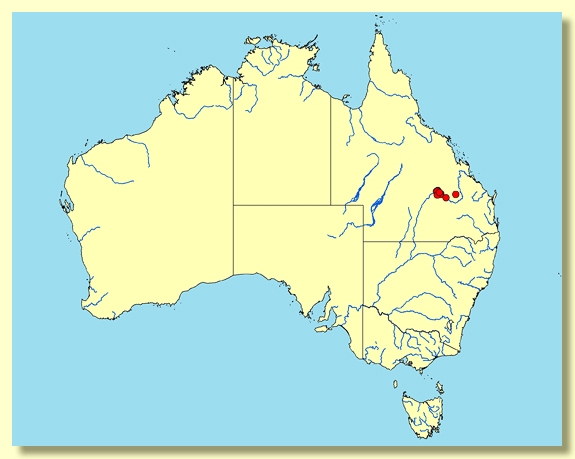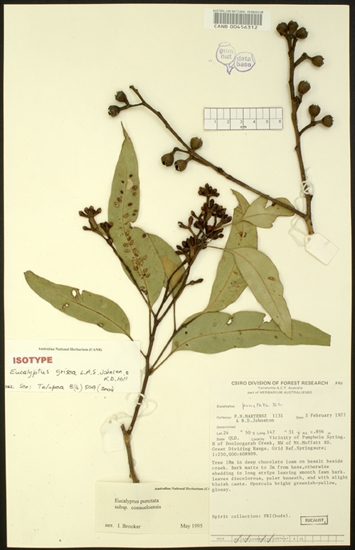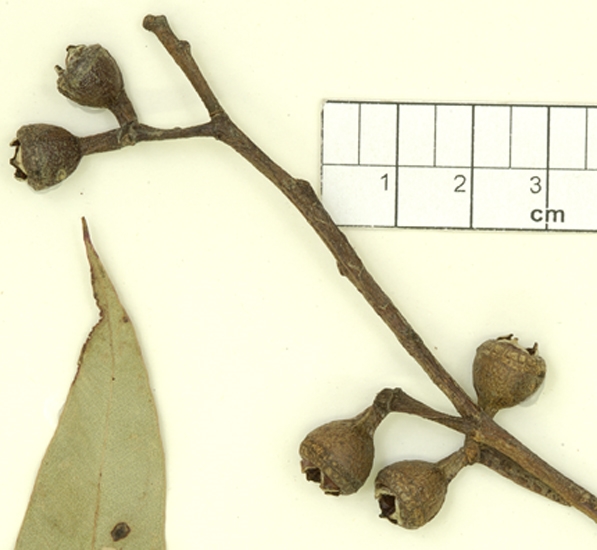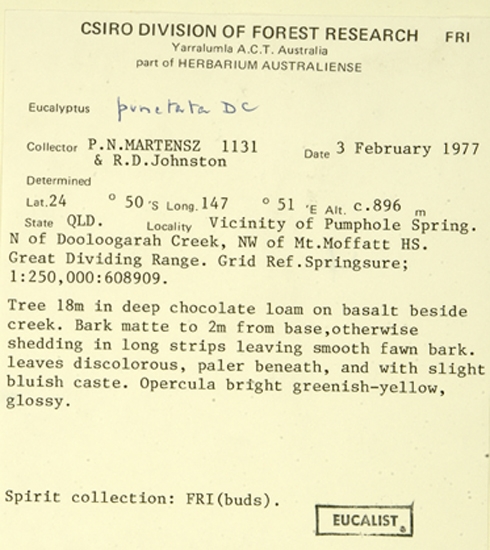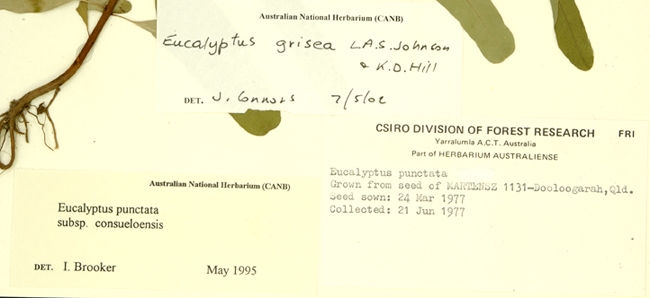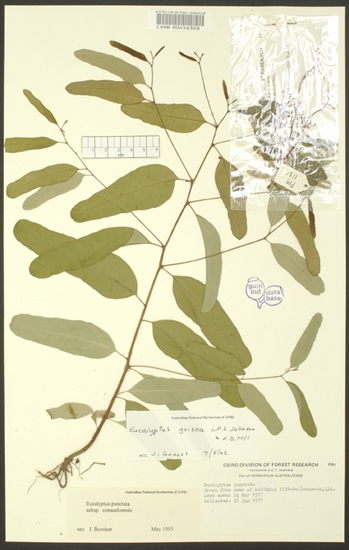Euclid - Online edition
Eucalyptus grisea
Eucalyptus | Symphyomyrtus | Latoangulatae | Lepidotae-Fimbriatae
Tree to 28 m tall. Lignotuber not recorded but expected to be absent like other closely related species.
Bark smooth throughout, becoming granular with age, predominantly grey to whitish to brown, mottled with cream, yellow or orange, shedding in patches.
Juvenile growth (coppice or field seedlings to 50 cm): stem rounded or square in cross-section; juvenile leaves always petiolate, opposite for 3–5 pairs then alternate, ovate to lanceolate, not measured, base rounded or tapering to petiole, discolorous, green.
Adult leaves alternate, petiole (1.5)1.7–3.3(4) cm long; blade lanceolate to broadly lanceolate to ovate, sometimes the narrower leaves slightly falcate, 8–18 cm long, (2.2)3–6(6.4) cm wide, base oblique or tapering to petiole, discolorous, glossy, dark green above and paler on the underside, side-veins greater than 45° to midrib, densely reticulate, intramarginal vein parallel to and just within margin, oil glands mostly island, occasionally intersectional.
Inflorescence axillary unbranched, peduncles 0.8–1.5(2) cm long, buds 7 per umbel, pedicellate (pedicels 0.2–0.4 cm long). Mature buds ovoid to obovoid (0.7–1 cm long, 0.4–0.5 cm wide), scar present, operculum conical, stamens inflexed, anthers cuboid, versatile, dorsifixed, dehiscing by longitudinal slits (non-confluent), style long, stigma blunt to tapered, locules 3 or 4, the placentae usually with 4 vertical ovule rows. Flowers white.
Fruit pedicellate (pedicels 0.2–0.5 cm long), normally cupular, rarely funnel-shaped to bell-shaped to hemisperical, 0.4–0.9 cm long, 0.8–1.2 cm wide, disc slightly raised or level, valves 3 or 4, exserted.
Seeds black, 1–2(2.2) mm long, cuboid or obliquely pyramidal, dorsal surface pitted, margins toothed, hilum terminal or obliquely positioned.
Cultivated seedlings (measured at ca node 10): cotyledons bilobed to oblong; stems square in cross-section; leaves always petiolate, opposite for 4 or 5 nodes then alternate, ovate-lanceolate, 5–11 cm long, (1.7)2–4.2(5) cm wide, base rounded to tapering, discolorous, darker green above, paler beneath.
Flowering time unknown.
A medium-sized tree endemic to the Carnarvon Ranges area of central Queensland. Characterised by its smooth grey gum granular bark, its discolorous adult leaves that are paler on the underside, and by its relatively broad juvenile leaves.
Eucalyptus grisea belongs in Eucalyptus subgenus Symphyomyrtus section Latoangulatae because cotyledons are bilobed, leaves are discolorous and have side-veins at a wide angle to the midrib, buds have two opercula and fruit have exserted valves. Within this section, it is one of six species forming series Lepidotae-Fimbriatae (the Grey gums) with ovules in 4(6) rows and the bark smooth throughout becoming granular with age. The series Lepidotae-Fimbriatae can be informally divided further into two groups based on seed colour and the presence or absence of small teeth on the seed edge. E. punctata, E. canaliculata, E. longirostrata and E. grisea all have black seed that are prominently toothed along the edges. E. propinqua and E. major have brown to light brown seed that have a much smoother surface texture than that of the other group, lacking the prominent teeth on the seed edge. Also the bark of E. propinqua and E. major tends to shed in strips rather than patches like the other grey gums.
It is very closely related to E. punctata and only differs marginally by having slightly wider juvenile leaves (2–5 cm wide in E. grisea and 1.5–3 cm wide in E. punctata) and a slightly flatter umbel peduncle. E. canaliculata from the Gloucester–Dungog region of New South Wales has larger fruit than E. grisea (1–1.5 cm wide for E. canaliculata and 0.6–1 cm wide for E. grisea).
The only other grey gum which may be confused with E. grisea is E. longirostrata. It also grows on the Blackdown Tableland in the same general area as E. grisea. Both can be easily separated on operculum shape. E. longirostrata has a relatively long beaked operculum while E. grisea has a much shorter acute operculum.
Red gums sometimes develop the dull granular bark like that of the grey gums. They should not be confused with grey gums as they have concolorous adult leaves, normally with moderate reticulation (always discolorous and reticulation dense to very dense for the grey gums).
Eucalyptus grisea: Latin griseus - grey, referring to the bark of the mature tree.



